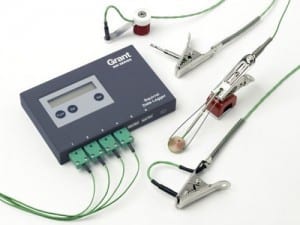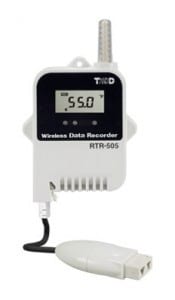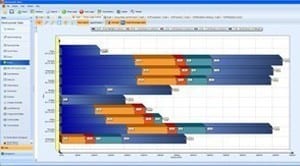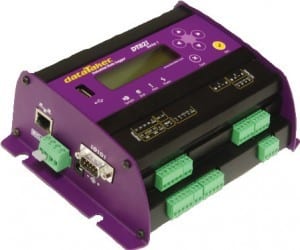Predictive Maintenance Helps Reduce Process Downtime
 As manufacturers continually search for ways to cut costs and increase ROI, machine monitoring basics and predictive maintenance (PdM) solutions are an increasingly cost-effective way for plants and factories to help reduce process downtime.
As manufacturers continually search for ways to cut costs and increase ROI, machine monitoring basics and predictive maintenance (PdM) solutions are an increasingly cost-effective way for plants and factories to help reduce process downtime.
One of the most common data logger applications is basic machine monitoring for all types of commercial, industrial, utility, and construction equipment. In the processing industry, condition monitoring of business-critical machines and electrical equipment is critical to help avoid process downtime and maximize ROI.
If you’re a factory manager or plant supervisor, you can use sensor-based data acquisition to stay on top of developing problems with your electrical equipment. Both management and technicians can benefit from these cost-effective solutions.
In our latest White Paper, CAS DataLoggers discusses the basics of condition monitoring and predictive maintenance for your invaluable process machinery.
Introduction:
With the advent of the Internet of Things, heavy industry is turning to sensor-based data collection to solve its greatest problems, chief among them being process downtime in the form of process delays and shutdowns.
Machine monitoring, aka condition monitoring or predictive maintenance, refers to the practice of monitoring electrical equipment via sensors to collect diagnostic data. To this end, data loggers and data acquisition systems are used to monitor all types of equipment including engines, motors, boilers, and more, all with an eye toward ROI.
Condition monitoring is a steadily growing business practice, with the market totaling nearly $11 billion according to a 2017 report from Research & Markets magazine forecasting opportunities for OEMs, plants, and factories. Industry leaders mentioned in the report include Caterpillar, Dell, General Electric, IBM, Microsoft, Siemens, and more.
 These applications also encompass many different types of needs aside from condition monitoring:
These applications also encompass many different types of needs aside from condition monitoring:
- Runtime/uptime measurement
- Preventative maintenance
- Performance tracking
- Energy monitoring/conservation
- Fault isolation
- Quality control
How Does Condition Monitoring Help Prevent Downtime?
As a plant manager or technician, you always need a heads-up of developing conditions in your facility’s equipment. Likewise, if you’re a purchasing agent, you’ll want to select the most appropriate monitoring device for your customer.
The basics of Machine monitoring can be either periodic or continual:
- Periodic: Periodic measurements are performed according to either a regular schedule or are taken erratically. Periodic monitoring is reliable only if it is done according to a set schedule, for example by a supervisor at a set time every day, or automated by a data acquisition system.
- Continual: Continual measurements are performed constantly by data acquisition systems via automated sensor-based data collection. Continual monitoring has the considerable advantage of being more dependable and a clearer indicator of developing machine damage or impending process downtime.
Condition Monitoring Applications:
- Heavy Machinery
- Oil & Gas
- Energy
- Automotive & Transportation
- And many other industries
If you’re the person using the data acquisition system, you’ll want to be sure that any prospective device not only suits your needs but is also easy to learn and operate. Meanwhile, if you’re a purchasing agent sourcing a control system, you can help to decrease your client’s downtime hours (in the form of process delays and shutdowns) by sourcing a Machine Monitoring solution.
Machine Monitoring Basics:
 Condition Monitoring Solutions include:
Condition Monitoring Solutions include:
- Data acquisition systems
- Data loggers
- Portable measurement systems
- Current/voltage loggers
- Vibration monitoring systems
Data acquisition/Machine Monitoring Systems:
Two major categories of products are used for condition monitoring:
- Dedicated data loggers designed for a specific function such as temperature recording or AC voltage measurement. These solutions are ideal when you know beforehand that you only need to measure one or two values or if you need to save on cost.
For example, we provide dedicated event loggers to track machine run-time or parts count, AC power loggers to record incoming voltage and/or current, and vibration analyzers to look at the dynamic behavior of rotating or moving equipment. - Universal input data loggers can be outfitted with a variety of sensors to record many different parameters simultaneously such as temperature, current, voltage, pressure, flow, or nearly any other value to track machine conditions in real time. While universal solutions are more flexible, they are also more expensive than single-purpose devices.
As an example of general-purpose, universal input data loggers, Series 4 dataTaker systems include models with 2 to 16 input channels, local alarm notification, and Modbus capability to interface with other equipment.
Sensor Arrays:
 Data acquisition systems incorporate various internal or external sensor types (temperature, current, voltage, etc.) to continually acquire machine data and compare it to user-set parameters such as normal operating temperatures, energy, power factor, etc.
Data acquisition systems incorporate various internal or external sensor types (temperature, current, voltage, etc.) to continually acquire machine data and compare it to user-set parameters such as normal operating temperatures, energy, power factor, etc.
For example, to monitor a boiler, the user might first attach a Type K thermocouple to its metal side, with leads trailing back to the data logger or data acquisition system. Then the operator configures the system to sample readings from the thermocouple sensor, say once every 15 minutes. This step, often called data acquisition or data sampling must be performed using accurate sensors and an accurate monitoring system to ensure reliable condition monitoring.
The monitoring device then stores this temperature data in its internal memory or, in the case of a wireless remote monitoring system, automatically transmits it to a remote PC or cloud storage server. Whether you’re performing periodic or continuous monitoring, once you’ve collected enough data this way, it’s time to look at the condition of your machinery using specialized software.
Visualization & Analysis Software:
Condition monitoring software allows users to visualize data from many distributed machines at once, and to analyze this data to identify faults before they can further develop and cause downtime.
 For example, in the middle of a production run, any sudden changes in any machine’s operating values can be instantly detected and responded to. Most importantly, maintenance work and process downtime can be scheduled and carried out in time to help avoid process delays and shutdowns, resulting in long-term ROI.
For example, in the middle of a production run, any sudden changes in any machine’s operating values can be instantly detected and responded to. Most importantly, maintenance work and process downtime can be scheduled and carried out in time to help avoid process delays and shutdowns, resulting in long-term ROI.
Data analysis is performed via specialized data acquisition software. Using a custom software application, data is analyzed according to user-set filters and portrayed in trend form via charts and tables showing what maintenance or repair actions are needed if any.
A complete software system will offer you data acquisition, analysis, visualization, and automation. The end-user should be able to get a clear and logical overview of all measurement systems, no matter how many machines are being monitored. Armed with this data, plant supervisors and technicians can then make presentations to management.
Which Measurement Value Should You Monitor?
Temperature:
Temperature is the most commonly measured value, and many basic machine monitoring applications require you to log temperature in tandem with another value.
Temperature recorders satisfy the needs of many different applications including:
- Electrical equipment monitoring (motors, turbines, etc.)
- Oven temperature profiling (part finishing, batch ovens, etc.)
- R&D (climate chambers, test stands, etc.)
Temperature data loggers are suitable for use with all common types of temperature sensors, including thermocouples, RTDs, and thermistors. The market offers a broad selection of temperature data loggers with a wide variety of features, communication options, storage, and notification capabilities to meet your project needs. Temperature recorders are available with or without displays, with wireless and LAN communication, and multi-channel systems with hundreds of inputs.
AC/DC:
A common data logging application is measuring voltage and current flowing into or out of a piece of equipment, such as a user monitoring current in wind turbines. These measurements can be broadly classified into two groups: AC and DC.
AC Voltage and Current:
A common voltage measurement application involves taking readings to ensure that a given piece of equipment is operating within its manufacturer’s recommended voltage range.
A variety of AC Voltage and Current Data Loggers are available with built-in transducers to support a specific voltage and/or current range. However, with a few exceptions, most data loggers cannot measure AC voltage or current directly and so require external transducers to convert the parameter of interest into a signal that the data logger can measure.
AC Current data loggers include models for 10 to 5,000 amps for equipment monitoring and metering.
- AC Current Transducers – A standard method of measuring AC current for a power line-connected device is to use an AC current transducer (single- or multi-phase) which converts an AC current to a DC voltage or a 4-20 mA signal that can be measured with the data logger.
- Clamp-on Current Sensors – Clamp-on current sensors are easy to use and available in a variety of models and current ranges with either DC or AC voltage outputs.
- Split Core Transformers – Split-core transformers are very similar to clamp-on current sensors but are intended for semi-permanent installations.
- Rogowski Coils –Rogowski coils are suitable for the measurement of currents up to thousands of amps. They’re easy to place around the conductor and can provide accurate phase response.
AC Voltage Measurements:
- AC Voltage Transducers – If your application involves tracking incoming line voltage, standard AC voltage transducers are available in both single- and multi-phase versions and with standard or True RMS calibrations.
- AC Voltage Signal Conditioner Modules – If you need to measure small AC voltages or a large number of channels, 5B series signal conditioner modules are available with 100 mV to 300V inputs.
DC Current/Voltage:
Many data loggers are specifically designed for the measurement of DC voltage and DC current. Some are designed for specific measurements which are easier to set up but offer less flexibility. There are also general-purpose data loggers that can measure DC voltage, current, and other input signal types.
Depending on the levels involved, some data logger models can directly measure DC voltage and current. For example, the dataTaker DT80 family of data loggers can accept DC voltages up to +/- 30 volts and DC currents up to 30 mA directly.
DC Voltage and Current Data Loggers:
For DC applications, there are data loggers specifically designed for taking voltage and current measurements using probes that can be directly connected to the signal source. These models typically cost less and are easier to set up, but in return, they offer less flexibility.
If you think that your range of measurements may change in the future, use a data logger with an external transducer which will allow you to change the input range by connecting a different transducer.
DC Current Measurements:
- Current Shunts –These conductors are available in ranges to handle 5 to 1000 amps and to provide an output from 0-1 volts.
- DC Current Transducers – DC current transducers often utilize a Hall Effect sensor to allow current measurement without direct contact with the conductor. They work very well for higher currents.
DC Voltage Measurements:
- Attenuators – The simplest method of measuring a DC voltage that is outside the measurement range of the data logger is to use an attenuator, which is a few resistors wired together to divide the incoming voltage to a range compatible with the data logger.
- DC Voltage Transducers – Many companies offer packaged DC voltage transducers that convert the incoming voltage to a range that is compatible with the data logger. These units can measure very small (< 0.1) and very high (>1000) volt inputs and can also provide an output either as a voltage or as a 4-20 mA signal.
- Signal Conditioner Modules – Standard signal conditioner modules such as the ubiquitous 5B series provide up to 1500 volts of isolation and amplification or attenuation in compact packages that are suitable for multi-channel systems. They are available in a wide range of input voltages and provide a DC voltage output.
Universal Input:
If you must monitor a mix of AC and DC voltage and/or current inputs, or if your voltage/current ranges are beyond standard input ranges, you can use a Universal Input logger. These loggers allow the measurement of most voltages and currents found in industrial applications.
These loggers also allow the measurement of other input signal types besides voltage and current and can be outfitted with transducers suitable for up to hundreds or thousands of amps that work with general-purpose data loggers. This also enables the simultaneous measurement of multiple input signal types. Users can measure almost any type of input – from mV and uAmps to thousands of volts or amps.
These versatile solutions can measure voltage, current, thermocouples, strain gauges, and many other sensor types. While universal dataloggers are more expensive than single-purpose loggers, they can greatly simplify more complex data-logging projects, saving both time and money. This flexibility provides you with several convenient advantages:
- You can move the logger from project to project without having to reconfigure the hardware
- Simultaneous monitoring of multiple variables with one data logger–for example, recording temperature using a thermocouple, logging voltage using a pressure sensor, and monitoring the pulse output using a flow meter.
- No matter what signal you’re logging in, you use the same software without needing to purchase additional packages or modules.
Remote Monitoring and Data Transmission in Plants:
To transmit and store all this data, many factories and plants opt for a remote data acquisition system capable of continuous data acquisition and evaluation. If you plan on replacing your facility’s legacy systems or redundant equipment, you’ll find that modern, PC-based data acquisition technology is a convenient solution for predictive maintenance.
 To get a heads-up on developing issues before they result in downtime, users rely on a variety of communications features to transfer data and alarm notifications to PCs or networks. This can be done via WiFi, Ethernet, Serial, FTP, cellular modem, and more. Cloud-based storage is another viable option.
To get a heads-up on developing issues before they result in downtime, users rely on a variety of communications features to transfer data and alarm notifications to PCs or networks. This can be done via WiFi, Ethernet, Serial, FTP, cellular modem, and more. Cloud-based storage is another viable option.
Remote Monitoring Systems Can Perform:
- Independent data acquisition
- Data Recording of analog and digital signals
- Remote Monitoring of data
- Data processing
Remote systems are also useful for immediate alarm notification via SMS text message in the event of limit violations, such as an overheated motor or a high tank temperature. For this crucial failsafe, first ensure that your prospective solution supports connection to your production and office networks and to the process control system (PLCs, etc.).
Plant Application Features:
- Independent data acquisition
- Online (remote) access to all measurement data and status information
- Instant alarm and fault notification via email and text messaging
- Automated offline data transmission at preset intervals via a scheduler
For example, in fault diagnostics in machinery and plants, typical remote applications include the evaluation of pressure pulses and surges, fast process monitoring and controller optimization, shock, and vibration measurement, and materials research and environmental simulation. When every minute counts, make sure you’re immediately made aware the moment your process is threatened.
Do You Need Control Capability?
If you need control capability for your machine monitoring application, many intelligent monitoring systems integrate this functionality. Recording in standalone mode fully independently from the PC, a control system performs:
- Pre- and post-trigger functions
- Synchronized data acquisition (angular and chronological)
- Evaluation of limit values and alarm capability
- Data reduction by online calculation of condensed parameters
Machine and plant limit values can all be adjusted in the GUI (graphical user interface) on the PC. Likewise, multiple machine states can be controlled and visualized using the same user interface.
ADwin Data Acquisition Systems are flexible, expandable, and easy to program using a real-time development tool. Users connect the ADwin system to the process control system via its analog and digital inputs or via serial interface and bus systems. It’s equally simple to transfer machine and process characteristics over to the device. Via Ethernet and a graphical user interface, the current machine state can be visualized on various PCs on the company network.
By integrating real-time data visualization into your production process, you’ll have the data to see how any given operation conditions are impacting your equipment’s characteristics. This setup also gives you a convenient way to instantly judge your compliance with specific process values (temperature, current/voltage, etc.).
Conclusion:
Condition monitoring, aka predictive maintenance, is a detailed but rewarding method to help prevent process downtime in your factory or plant. By closely monitoring your operation-critical machinery and providing process overwatch, data acquisition systems can aid your business in the form of long-term stability and ROI.
The Solutions Experts:
At CAS DataLoggers, we have the most complete selection of data acquisition systems and data loggers available anywhere. With hundreds of data logger models ranging from 1 to 300 channels, users can record temperature, voltage, current, resistance, vibration, digital signals, and more. We also offer a wide variety of wireless, wired, and custom-made systems.
We can provide you with condition monitoring systems along with visualization software and free on-call technical support. Our experienced Inside Engineering department also offers value-added services including on-site installation, custom programming, engineering and design services, and turn-key systems.
For more information on our inventory of Machine Monitoring Data Loggers, or to find the ideal solution for your application-specific needs, contact a CAS DataLoggers Application Specialist at (800) 956-4437 or contact us here with any questions.


